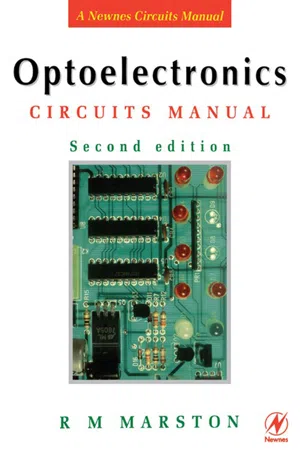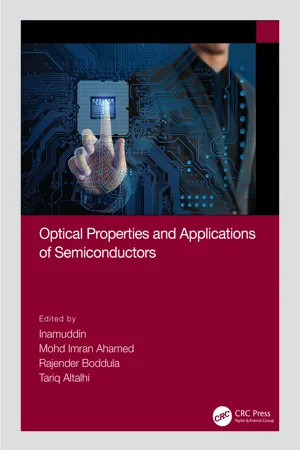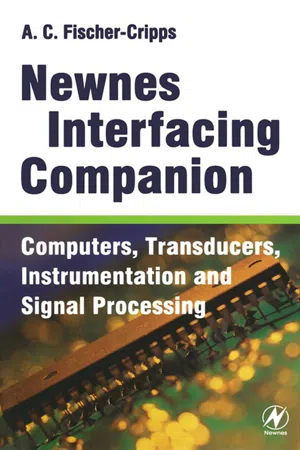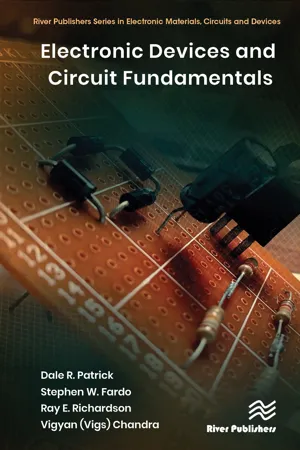Physics
Photoresistor
A photoresistor is a type of resistor that changes its resistance based on the amount of light that falls on its surface. It is also known as a light-dependent resistor (LDR) and is commonly used in light-sensing applications such as streetlights, cameras, and solar panels. The resistance of a photoresistor decreases as the intensity of light increases.
Written by Perlego with AI-assistance
Related key terms
1 of 4
Related key terms
1 of 3
4 Key excerpts on "Photoresistor"
- eBook - ePub
- R M MARSTON(Author)
- 1999(Publication Date)
- Newnes(Publisher)
6Light-sensitive circuits
The previous four chapters have dealt with the theory and applications of light-generating and light-reflecting devices such as LEDs and LCDs. The present chapter concentrates on the operating principles and applications of light-sensitive devices such as LDRs and photodiodes, etc.LDR basics
Electronic optosensors are devices that alter their electrical characteristics in the presence of visible or invisible light. The best known devices of these types are the LDR (light dependent resistor), the photodiode, the phototransistor, and the PIR (passive infra-red) detector.LDR operation relies on the fact that the conductive resistance of a film of cadmium sulphide (CdS) varies with the intensity of light falling on the face of the film. This resistance is very high under dark conditions and low under bright conditions. Figure 6.1 shows the LDR’s circuit symbol and basic construction, which consists of a pair of metal film contacts separated by a snake-like track of light-sensitive cadmium sulphide film, which is designed to provide the maximum possible contact area with the two metal films. The structure is housed in a clear plastic or resin case, to provide free access to external light.Figure 6.1 LDR symbol (a) and basic structure (b)Practical LDRs are available in a variety of sizes and package styles, the most popular size having a face diameter of roughly 10mm. Figure 6.2 shows the typical characteristic curve of such a device, which has a resistance of about 900R at a light intensity of 100 Lux (typical of a well lit room) or about 30R at an intensity of 8000 Lux (typical of bright sunlight). The resistance rises to several megohms under dark conditions.Figure 6.2 Typical characteristics curve of a LDR with a 10mm face diameterLDRs are sensitive, inexpensive, and readily available devices with power and voltage handling capabilities similar to those of conventional resistors. Their only significant defect is that they are fairly slow acting, taking tens or hundreds of milliseconds to respond to sudden changes in light level. Useful LDR applications include light- and dark-activated switches and alarms, light-beam alarms, and reflective smoke alarms, etc. Figures 6.3 to 6.22 - Inamuddin, Mohd Imran Ahamed, Rajender Boddula, Tariq Altalhi, Inamuddin, Mohd Imran Ahamed, Rajender Boddula, Tariq Altalhi(Authors)
- 2022(Publication Date)
- CRC Press(Publisher)
6 Semiconductor Photoresistors Anoop Singh, Aamir Ahmed and Sandeep Arya DOI: 10.1201/9781003188582-6 CONTENTS 6.1 Introduction 6.2 Types of Photoresistors 6.2.1 Intrinsic Photoresistor 6.2.2 Extrinsic Photoresistor 6.3 Working Principle of Semiconductor Photoresistor 6.4 Characteristics of Semiconductor Photoresistor 6.4.1 Wavelength Dependency 6.4.2 Dependent on Sensitivity 6.4.3 Latency Dependent 6.5 Applications of Semiconductor Photoresistor 6.5.1 Light Sensor 6.5.2 Audio Compressors 6.5.3 Measurement of Incident Light Intensity 6.5.4 Light Control Circuit 6.5.5 Automatic Street Lighting 6.5.6 Wearable Image Sensing Applications 6.5.7 Photogate Timing with a Smartphone 6.6 Conclusion References 6.1 INTRODUCTION The word “Photoresistor” is made of two words “photons” and “resistor”. The Photoresistor is a special kind of resistor that is used in electronic circuits. The Photoresistor may be defined as a resistor, the resistance of which depends upon the intensity of light incident upon it. The resistance of the Photoresistor changes with the intensity of light. It comprises a conductor material that is sensitive towards light, i.e., photo-conductive material. The phenomenon governing Photoresistor is very simple, light is made incident on a Photoresistor, and excitation of electrons takes place from the valence to conduction band. More is the number of electrons transferred towards the conduction band, less will be the resistance offered by the Photoresistor. The material that is most commonly used for fabricating Photoresistors is a highly resistive semiconductor. In terms of conductivity, the materials are characterized as conductors, semiconductors, and insulators. In a conductor, the electrons can move on applying a potential across the conductor, whereas in an insulator, the electrons cannot move freely [ 1 ]. The semiconductors have attained huge interest in recent times as it has the conductivity in between the insulators and conductors- eBook - ePub
Newnes Interfacing Companion
Computers, Transducers, Instrumentation and Signal Processing
- Tony Fischer-Cripps(Author)
- 2002(Publication Date)
- Newnes(Publisher)
pyroelectric property of certain ferroelectric materials. Incident radiation causes a change in the surface charge of a residually polarised ceramic. The effect can only be measured in a pulsed mode of operation and hence an AC amplifier is used to produce a reasonable output.1.3.5 Light dependent resistor (LDR)
In a semiconductor, photoconductivity is a result of an increase in electrical conductivity due to impingement of photons on the semiconductor material. This increase can only occur if the incident photons have an energy hv > Eg where Eg is the energy gap between the valence and conduction bands.Incident photons cause electrons in the valence band to be given energy hv and, if hv > Eg , valence electrons enter the conduction band, leading to an increase in the number of mobile electrons.The increase in conductivity manifests itself as an increase in the current through the device for a given applied voltage and as such may be called a light dependent resistor (LDR). When an LDR is illuminated with a steady beam, an equilibrium is reached where the decay of electrons is matched by the excitation.The ratio of the number of excited electrons to the number of incoming photons is called the quantum efficiency and is dependent on the probability of the number of elastic collisions between photons and electrons.For a given frequency of incident beam, the number of mobile electrons created is a function of intensity of the beam. However, the conductivity of the material depends not only on the intensity of the incident radiation, but also upon its frequency . This is due to the filling of available quantum states.e.g. A popular material for LDRs is cadmium sulphide (CdS). CdS has a peak response at 600 nm, Eg = 2 eV and matches the frequency response of the human eye quite closely. In contrast, lead sulphide (PbS) (Eg - eBook - ePub
- Dale R. Patrick, Stephen W. Fardo, Ray E. Richardson, Vigyan (Vigs) Chandra(Authors)
- 2023(Publication Date)
- River Publishers(Publisher)
wavelength. This symbol shows that the resistor responds to light wavelengths. When these devices are connected in a circuit as indicated, an increase in light intensity causes a reduction in resistance. This causes a corresponding increase in device current and a reduction in voltage across the device. In a sense, this type of device responds as a variable resistor that is controlled by light intensity.An application of the photoconductive cell is shown in Figure 13.19 . In this circuit, the SCR conducts when light is focused on the photoresistive cell. When light strikes the photoresistive cell, its resistance decreases. The potential at point A becomes more positive and causes gate current (IG )to flow. A sufficient amount of gate current triggers the SCR into conduction. When the SCR conducts, the load device is activated. The SCR then conducts until its anode circuit is opened. The variable resistor (R1 ) is used as a sensitivity adjustment to control the level of light required to cause the SCR to conduct.Figure 13.18Schematic symbols of a CdS cell.Figure 13.19Photoconductive cell application.Photodiodes
Photodiodes are also classified as photoconductive devices. This type of device has light-sensitive P-type and N-type materials in its construction as shown in Figure 13.20(a) . Note that the two materials form a P-N junction. Normally, a photodiode is connected in the reverse-biased mode of operation. Without light, there is an extremely high reverse resistance. Any conduction current that flows is called dark current. As a rule, dark current is due to the thermal generation of current carriers. Only a few nanoamperes (nA) of dark current occur in a reverse-biased photodiode at low light levels.Photodiodes are energized in a circuit with reverse-biased DC. When a photodiode is illuminated, radiant energy causes the valence electrons of the P-type and N-type materials to go into conduction. In effect, this causes electrons and holes to be returned to the current carrier depletion region near the reverse-biased P-N junction. The return of current carriers increases conductivity and lowers junction resistance. A photodiode changes its conductivity with light intensity only when the junction is reverse biased. Forward biasing the same P-N junction causes conductivity that does not change with light intensity. Photodiodes find use in smoke detectors where the amount of light reaching the photodiode is continuously monitored. If the light is blocked, which may happen due to smoke, the conductivity of the photodiode changes and this can be used to trigger an alarm. Photodiodes are also used in the receiver circuitry of a VCR or television that is remotely controlled. Other applications include light meters
Index pages curate the most relevant extracts from our library of academic textbooks. They’ve been created using an in-house natural language model (NLM), each adding context and meaning to key research topics.
Explore more topic indexes
Explore more topic indexes
1 of 6
Explore more topic indexes
1 of 4



